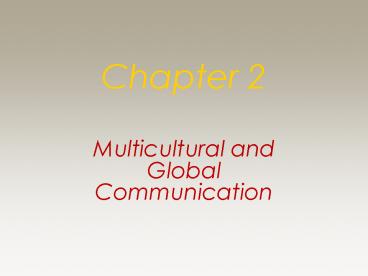Multicultural and Global Communication - PowerPoint PPT Presentation
1 / 24
Title:
Multicultural and Global Communication
Description:
Chapter 2 Multicultural and Global Communication Communication Across Cultures is Necessary due to: Outsourcing Offshoring E-commerce Culture Customary beliefs ... – PowerPoint PPT presentation
Number of Views:2255
Avg rating:3.0/5.0
Title: Multicultural and Global Communication
1
Chapter 2
- Multicultural and Global Communication
2
Communication Across Cultures is Necessary due
to
- Outsourcing
- Offshoring
- E-commerce
3
Culture
- Customary beliefs, social norms, values,
material traits, and behavior patterns
transmitted from generation to generation that
distinguish groups of people
4
Corporate Cultural Dimensions
- Behavioral expectations
- Values
- Patterns of operation
- Beliefs
- Assumptions
- Norms
- Customs
- Rituals
- Symbols
5
Core Cultural Dimensions
- Ethnicity
- Race
- Gender
- Age
- Physical disability
6
Cultural Ethnicity and Race
- Ethnicity relates to common history.
- Race relates to characteristics transmissible by
descent.
7
Gender Roles
- Men and women tend to communicate differently.
- Societal expectations of men and women affect how
they interact with one another.
8
Age Diversity
- Age and stage of life affect individuals values
and how others perceive them.
9
Physical Disability
- The Americans with Disabilities Act (ADA)
removes unreasonable barriers to employment in an
effort to prevent discrimination against people
with disabilities.
10
Multicultural Perspectives
- Cultural background affects communication.
- Cultural diversity in the workplace and in the
marketplace has increased. - Greater understanding of the connection between
culture and communication is necessary.
11
Cross-Cultural Communication Barriers
- Cultural relativism
- Ethnocentrism
- Lack of knowledge and understanding of other
cultures - Discriminatory behaviors including harassment
- Language differences
12
Cultural Relativism
- Compares the values and behaviors of different
cultures and usually means judging them against
standards of right and wrong from your own culture
13
Ethnocentrism
- The inherent belief that your own cultural
traditions and values are correct and superior
14
Stereotypes
- Assumption that behaviors or characteristics
typical of a particular culture define all
members of that cultural group - Result from a limited knowledge of cultural
diversity
15
Discrimination
- Showing favoritism or prejudicial rejection of
people because of differences
16
Sexual Harassment
- Unwelcome behavior of a sexual nature or with
sexual overtones - Quid pro quo
- Hostile environment
17
Languages
- Language differences may be a barrier to
effective business communication.
18
Nonverbal Language
- Influences the receivers understanding and
acceptance of a message - Is believed rather than the verbal message if the
two are inconsistent
19
Multicultural Communication Guidelines
- Understand your own culture.
- Keep an open mind and respect diversity.
- Identify and adapt to language differences.
20
Multinational and Global Business
- Multinational business operations targeted
toward and conducted in two or more countries - Global business operations and strategies to
serve a world market
21
High Context Cultures
- Place high value on relationships
- Favor indirect communication
22
Low-Context Cultures
- Value productivity
- Prefer direct communication
- Give minimal attention to relationship building
23
Speaking and Writing for a Global Audience
- Learn and use a few phrases and greetings in the
receivers native language. - Use the indirect or direct style to match the
style of the receiver.
24
Global Communication Strategies
- Review business communication principles.
- Analyze the message receiver.
- Be open to and accepting of other cultures.
- Learn about other cultures and apply what you
learn. - Consider language needs.

